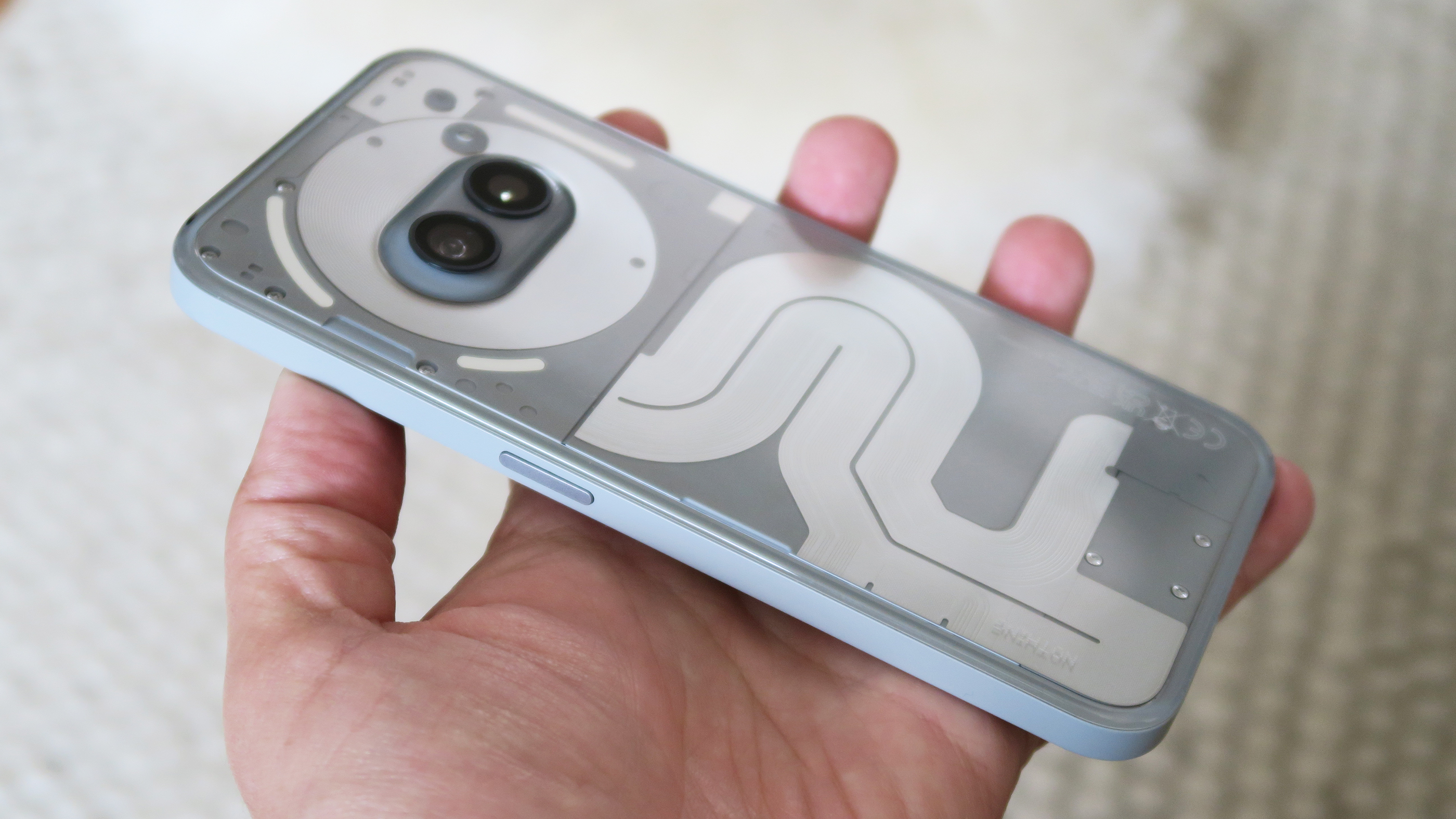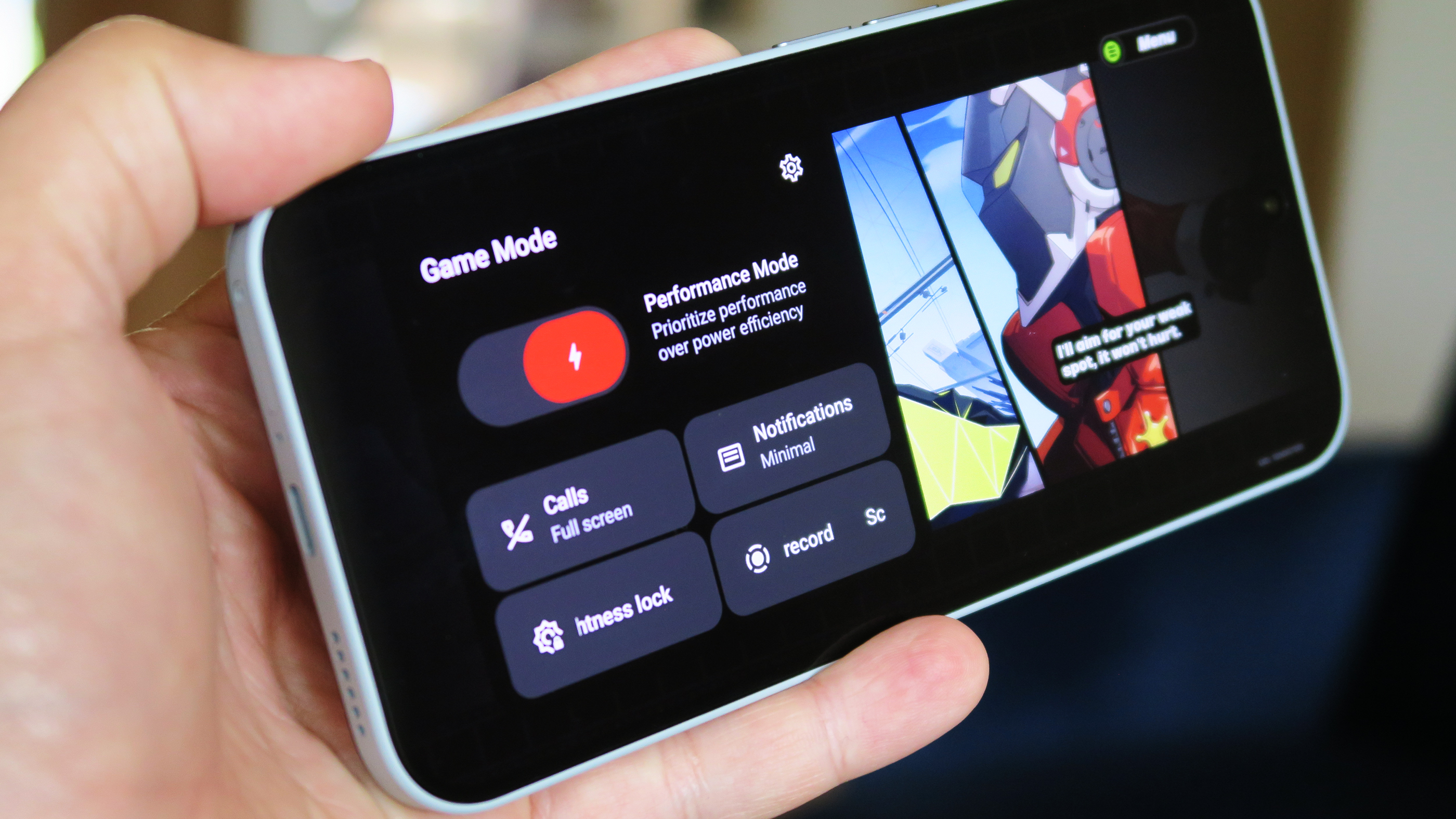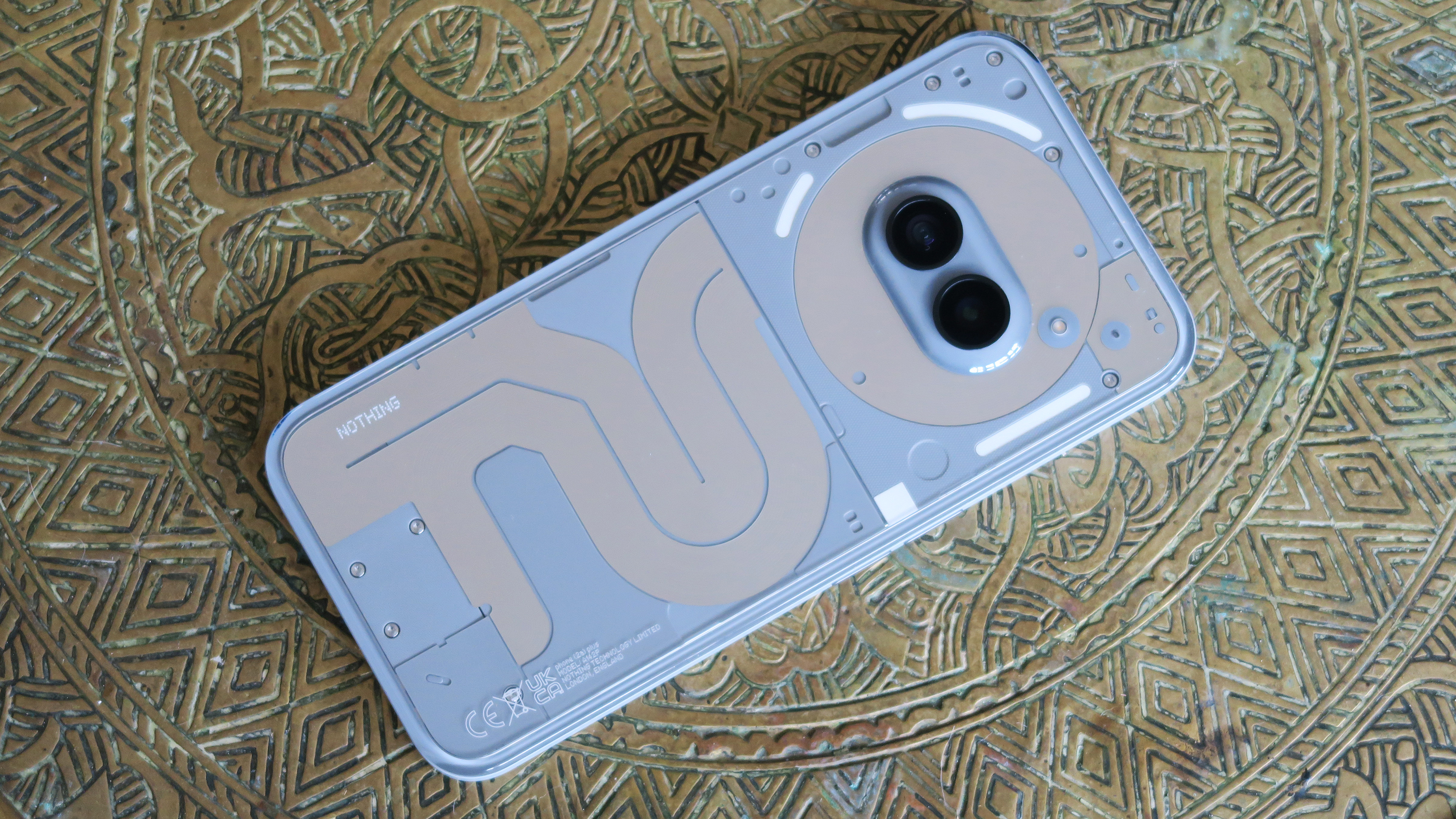
Nothing Phone 2a Plus: Two-minute review
Nothing has already confirmed that its next flagship smartphone – the Nothing Phone 3 – won't be making its debut until 2025, but that doesn't mean fans of the brand aren't without new phones to get excited about in the meantime.
In March, we were introduced to the Nothing Phone 2a: a device with all the sensibilities of the current top-tier Nothing Phone 2, but with more modest hardware and a price tag to match. It did well – very well in fact, becoming the brand's best-selling smartphone to date, and proving that a market exists for the company's distinct design aesthetics and forward-looking user experience in a more affordable package.
It's this success (and the long wait for another flagship phone from the company) that likely led to the creation of the Nothing Phone 2a Plus: a new variant of the 2a, announced only four months after the original's arrival.

The 2a Plus is much the same phone as its namesake, but rather than being a larger-screened version of the 2a, the 'Plus' in this instance actually refers to the slight uplift in performance, camera hardware, and battery tech boasted by this refreshed model over the standard iteration; although it does also come with a price increase to match.
On sale from September 10 for $50 / £50 / AU$40 more than the equivalent storage capacity Phone 2a, the 2a Plus remains mostly unchanged; with the same transparent polycarbonate-backed design (this time with extra metallic detailing), the same strong 6.7-inch 120Hz AMOLED display, the same rear cameras, same battery capacity, and same software promise.
The higher asking price buys you, among other things, a beefier Dimensity 7350 Pro chip, which delivers on the promised benchmarks of 10% better CPU performance and 30% greater graphical performance, compared to the more modest MediaTek chip powering the standard Phone 2a. You also get 50W charging, compared to 45W on the 2a that's – as you might expect – fractionally quicker (a full charge takes just under, compared to just over, an hour), and a new higher-resolution 50MP front camera (compared to a 32MP snapper on the 2a), which serves up more detail; not to mention the Plus boasts a richer shooting experience, thanks to a new AI-supported 'Vivid' mode.
All in all, the question is not whether Phone 2a users have been short-changed and if there's any point in upgrading (there isn't). Instead, the Nothing Phone 2a Plus edges the needle closer to the performance of the company's current flagship (especially graphically) for a lot less, whereas we saw the standard model as more of an improvement on the original Nothing Phone 1, as you'll read in our original Nothing Phone 2a review.
You still pay a premium for that Nothing aesthetic and unique Glyph lighting, though, meaning similarly-priced rivals offer more in areas like software support, faster charging, or a superior viewing experience, but at the expense of the sense of style that Nothing has cultivated with its products.
Nothing Phone 2a Plus review: Price and availability

- Priced at $399 / £399 / AU$639
- On sale from September 10, 2024
- US availability via Nothing Beta Program
The Nothing Phone 2a Plus comes in a sole 12GB RAM / 256GB storage variant, which means, in most markets, it comes in at a single price (you can get it with 8GB or 12GB of RAM in India). In Nothing's homeland of the UK, the phone costs £399 (direct from Nothing), £50 more than the original asking price of an equivalent 256GB standard Phone 2a.
Even in the short months since the standard 2a debuted, however, the company has already officially cut its price in key markets. A 256GB 2a costs £329 at the time of writing, meaning you actually pay £70 more for the Plus today.
The assumption is that the Phone 2a will remain on sale until Nothing runs out of stock, at which point the 2a Plus will be the company's sole mid-ranger (the newer phone should also come with a price reduction of its own by that point).
In the US, as with the Phone 2a, the 2a Plus is currently only available through the company's Beta Program. Despite being competitively priced in the market, there are caveats to purchasing this phone in the region; namely a significantly shorter 14-day return period and – as the devices being sold are international models – incomplete support for US carrier bands (i.e. spotty cellular connectivity with major US networks).
If, like the Phone 2, Nothing decides to launch the 2a Plus Stateside officially, the model sold will feature more complete US carrier support, but the company hasn't announced any such plans at the time of writing.
- Value score: 4 / 5
Nothing Phone 2a Plus review: Specs
Nothing Phone 2a Plus review: Design

- Iconic Nothing aesthetic
- IP54-certified polycarbonate body
- Repels scuffs well but back attracts smudges
While the Phone 2a marked a slight departure from the company's previous smartphones, with its main dual camera placed transversely along the center line of the phone's back, rather than being offset in the corner, it otherwise carried across all the hallmarks of the Nothing's now-established design language.
The Phone 2a Plus echoes the standard model's dimensions, weight, and aesthetic identically; there's a transparent polycarbonate back, under which you'll find tracks of faux circuitry, a cluster of diffused LEDs around the camera, which make up the phone's Glyph Interface, and a matte plastic frame, with a power button set into the right side and large volume up and down keys along the left edge.
It's in the color department where Nothing has set the 2a and 2a Plus apart visually. While the standard phone arrived in black or Milk (white) – both variants also sported a red accent – the 2a Plus can be bought in either Black or Grey, with that circuitry no longer color-matching the bodywork, and instead sporting a more eye-catching reflective silver finish.



It's a simple and effective way to distinguish the Plus from the standard 2a, and it feels a little more premium, too. However, I do miss the cleaner look of both launch finishes of the standard 2a (especially Milk).
In the hand, the proportions and weight of the 2a Plus make it a surprisingly comfortable phone to use one-handed. For its size, it feels beautifully put together, especially for a device that is, externally, mostly polycarbonate. Scuffs and scrapes are repelled surprisingly well; I just wish it didn't hold onto smudges so readily.
Nothing goes into some detail on the stress testing the 2a line is subjected to, for peace of mind, but the build is also independently certified against dust and water ingress with an IP54 rating; not quite as advanced as high-end devices, but perfectly at home for use in wet weather and the like.
- Design score: 4 / 5
Nothing Phone 2a Plus review: Display

- 6.7-inch 120Hz Full HD+ OLED
- Protected by Gorilla Glass 5
- Sluggish in-display optical fingerprint sensor
Sticking with aesthetics, Nothing's love for flexible OLED panels grants the Phone 2a Plus balanced bezels around its flat 6.7-inch Full HD+ (1084 x 2412) screen; framing things neatly with a 91.65% screen-to-body ratio (for comparison, the pricier Galaxy A55 sports a 86.9% ratio).
The display is protected by both a factory-fitted screen protector and Gorilla Glass 5 (i.e. not Corning's latest and greatest, but respectable in terms of both impact and scratch protection), and after several weeks of use, my device only picked up one or two superficial abrasions.
That upgraded front-facing camera sits neatly at the center of the panel's top edge, while an optical under-display fingerprint sensor hangs down near the bottom bezel. Practically, I think the sensor placement is a little too low, and, surprisingly, the response time of this particular fingerprint reader is well behind what I've come to expect from the technology. We're talking milliseconds here, but I hope Nothing works to improve read speed via subsequent updates, as it lags behind the quality of the rest of the experience served up by the 2a Plus.

As for the panel itself, it's the same screen found on the standard 2a, with nice colors, contrast, and a respectable 1,100-nit average maximum brightness (with a 1,300-nit peak). Other reviewers have reported fractionally better brightness scores from the panel on the 2a Plus, compared to the 2a, but anecdotally I never saw a noticeable difference while testing them side by side; both are visible in bright conditions, even if there is plenty of room for improvement.
While the use of OLED tech ensures nice vibrant colors and deep blacks, the 2a Plus doesn't pack LTPO tech, meaning the 120Hz refresh can step down to 30Hz, but no lower, and in fairly sizable increments, too. In practice, the OS tends to err on the side of fluidity, even if that means higher power consumption (you do have the ability to cap it at 60Hz manually, if you prefer).
Nothing doesn't grant a huge amount of control over customizing the viewing experience, beyond including always-on display (AoD) support and Night Light (which warms display color temperature when it's dark or late). You have Alive or Standard color profiles to choose between, with a warm-to-cool slider, too, but again, while appreciated, this is a comparatively bare-bones take on display personalization, compared to what you'd find on equivalent Xiaomi.
- Display score: 3.5 / 5
Nothing Phone 2a Plus review: Software

- 3 years of OS & 4 years security updates
- Launches with Nothing OS 2.6 atop Android 14
- Nothing AI news widget is novel but has provenance issues
Nothing OS fast found a home among fans, thanks to its distinct, minimalist aesthetic, monochrome icon and widget theming, and as the means of interaction with the defining functional design feature of the brand's phones: the Glyph Interface.
Since the original Nothing Phone, the company has continued to build out this experience with new functionality, without straying from the path; ensuring a consistent experience across all its devices at all price points (from the top-tier Phone 2, down to the recently released affordable CMF Phone 1).
Like the standard Phone 2a, the 2a Plus arrives on Android 14 but sports the latest (at the time of writing) Nothing OS 2.6. The experience is as great as every other Nothing Phone, with the look and feel being one of its major draws. It's really nice to use, slick, and responsive on the 2a Plus thanks to that high refresh rate display. The ability to have supersized folders and app icons is a nice, unique bit of personalization and the native widgets are oozing with the dot matrix charm that embodies Nothing OS' visual style.

One of the most interesting additions in Nothing OS 2.6 is a new news widget. Add it to your home screen and select as many topics as you like from a shortlist of seven during the initial setup screen (these include business, entertainment, sports, technology, and more).
Once set up, tap the widget each day to hear an impressively convincing AI-generated version of Nothing's CFO Tim Holbrow read out various stories, covering your chosen topics. It's a novel and convenient way to digest current affairs, and a meaningful implementation of free AI functionality that few other mid-rangers come close to offering. There are, however, some obvious drawbacks.
For one, you have no idea about the provenance of the stories being read out. Even during setup, the widget never cites its sources, and there's no way to dive deeper or access the source material on a story Tim just read to you. There's the obvious risk of AI hallucination to consider with a tool like this, too, not to mention the ethical quandary of fair attribution to the journalists whose work this widget has scraped for content.
While I like the method of delivery, here's hoping subsequent updates iron out at least some of the pitfalls with this otherwise capable news widget.

Despite its lower standing in Nothing's smartphone portfolio, the 2a Plus doesn't lose out on the brand's signature Glyph Interface – the diffused LED segments around the phone's rear camera.
There are far fewer than on the Phone 2, but the trio that are present still fulfill all the same functions: as visual indicators for incoming calls and notifications when the phone is face down, to represent timers and ETAs on supported apps, and as a softer fill light when shooting video. You can also create your own Glyph patterns by downloading Nothing's Glyph Composer app, which is a fun bonus.
While not everyone will appreciate a phone that flashes (you can disable it if you don't like the Glyphs at all), it's another novel and aesthetic-defining characteristic of Nothing's phones and I appreciate its presence; although I wish more third-party developers put it to use, as it doesn't feel like it's being utilized to its full potential.

When it comes to software updates, Nothing is great at constantly pushing fixes and features to its devices; it's far more prolific than bigger brands like Motorola or Sony, and they should take note, as it constantly feels like your phone is improving. Nothing's also great at granting its users early access to Android betas, ahead of each OS' full release, which right now means you can technically already get your hands on Android 15, if you're willing to hazard its unfinished state.
The flip side is that software promises have become increasingly competitive in the market, with Apple and, more recently, the likes of OnePlus, Samsung and Google pushing for five, six or even seven years of support on its latest devices.
In the case of the Phone 2a Plus, the promise of three years of OS updates and four years of security updates seems acceptable for the phone's mid-range standing, but looks like a much weaker proposition on the more expensive Phone 2. If Nothing has the resources, being able to up those numbers would keep it competitive.
- Software score: 4 / 5
Nothing Phone 2a Plus review: Camera

- Same dual 50MP rear sensors as Phone 2a
- Upgraded 50MP front camera
- New Vivid Mode with real time analysis
The Phone 2a's distinct rear dual 50MP sensors (a Samsung GN9 for the main sensor and a Samsung JN1 for the ultra-wide) remain unchanged from the standard Phone 2a, as does the Imagiq 765 ISP (image signal processor) handling things behind the scenes; despite the change in silicon between the two phones.
The more prominent difference is the upgraded front camera, which sees the 2a's 32MP snapper traded for another 50MP JN1 (yes, the same sensor used by the ultra-wide). The result is higher-resolution selfies with a different capture profile and the ability to shoot 4K video on the phone's front, too.
Nothing Phone 2a Plus camera samples




















Side by side, selfies taken on the 2a Plus display greater detail and dynamic range in well-lit scenes. However, the fact that shots are captured at 50MP natively, and not pixel-binned, means blurring and detail loss in low light conditions is prevalent.
Portrait shooting across the front and back sensors can be hit and miss, too, with edge detection from the Portrait Optimizer within Nothing's TrueLens Engine (i.e. its camera software) tripping up from time to time. Otherwise, results are good.
Another camera addition that remains unique to the Phone 2a Plus is Vivid Mode; not even the Phone 2 running the same version of Nothing OS has this feature, at the time of writing. Not only does Vivid Mode change the color science employed to achieve more saturated shots, but it also uses AI to analyze what's in-frame and serves up real-time insight into what it's actually doing.

It's another novel use of AI, but one that shows Nothing is thinking about new ways to enhance the mobile photography experience and also give the user more insight into how to compose shots and what to consider. Vivid Mode lends itself well to further improving low-light shots, too.
- Camera score: 3.5 / 5
Nothing Phone 2a Plus review: Performance

- 3nm MediaTek Dimensity 7350 Pro chipset
- 8GB / 12GB RAM w/ RAM Booster up to 20GB
- Sole 256GB storage variant (non-expandable)
One of the three tentpole upgrades – and perhaps the most significant – that the 2a Plus lords over the standard 2a is a new chipset. MediaTek has once again supplied Nothing with an exclusive variant of its mobile silicon variant, which promises a 10% CPU uptick and up to a 30% graphical performance boost, compared to the Dimensity 7200 Pro that powers the vanilla Phone 2a.
In practice, my benchmark results suggest more modest improvements (about 3.5% better in CPU, 6% in AI, and 12% in GPU performance). That said, this doesn't detract from the fact that this Dimensity 7350 Pro-powered phone is more capable outright; scoring closely to the original Phone 1, as well as more recent rivals, like Samsung's Galaxy A35 and Galaxy A54, along with the Tensor G2-powered Google's Pixel 7 line.
By default, high-fidelity 3D titles like Zenless Zone Zero default to 'low' graphical settings at 30fps and deliver perfectly consistent performance at that level. If you want to dial things up to 'high' at 60fps, though, the 7350 Pro seems happy to be pushed in short bursts; you'll just start to notice heat build-up (there is a vapor chamber to help internal cooling) and the occasional dropped frame after about 20 to 30-minutes of play time, as I did.
Nothing is keeping things simple with a single 256GB (non-expandable) storage option in all markets, with most of the world getting 12GB of RAM. You can also use the RAM Booster tech in Nothing OS to allocate some of that storage as additional memory to give you up to an additional 8GB of virtual RAM), if desired, allowing more apps to remain in suspension in the background.
Beyond the engine of the phone, the performance of its asymmetrical stereo speaker setup also surprised and impressed, with a much fuller and clearer sound than you'd expect for a mid-ranger such as the Plus, not to mention some usable bass, too.
- Performance score: 3.5 / 5
Nothing Phone 2a Plus review: Battery

- 5,000mAh battery
- Fastest-charging Nothing Phone yet, at 50W
- 7 hours of screen-on time per charge
The 2a Plus is tied for the largest battery capacity on a Nothing Phone, at 5,000mAh, but it trumps the rest of the range – including the Phone 2 and 2a – when it comes to fast charging; with an elevated top speed of 50W.
While we're not approaching OnePlus or Xiaomi numbers here, 50W is decently fast against key competitors; so fast, in fact, that Nothing's own-brand charger 45W can't refill the Phone 2a Plus at full speed. For that, the $39 / £39 CMF Power 65W GaN charger is the next-best thing; especially as Nothing doesn't include a power adapter in-box, just its iconic transparent-ended USB-C cable.
In testing, the Phone 2a Plus reached 40% charge in 15 minutes, over 70% in 30, and a full charge took just under an hour (55 minutes). As you might expect, with only a 5W uptick compared to the standard Phone 2a, the gains in fast-charging are limited; the base 2a hit 30% charge in 15 minutes, just over 60% in 30, and recharged completely in just over an hour, under the same conditions as the Plus.
Screen-on time for the 2a Plus is respectable at 7 hours per charge, which should see most users through a day and a half of use without worry (the Phone 2a offered on average 6 hours and 45 minutes of screen-on time). For added peace of mind, Nothing also states that even after 1,000 charge cycles, the 2a Plus' battery will retain 90% of its original capacity, which is well above the kinds of figures rivals promise; perhaps even an industry-leading claim.
- Battery score: 4 / 5
Should you buy the Nothing Phone 2a Plus?
Buy it if...
Don't buy it if...
Nothing Phone 2a Plus review: Also consider
The specific blend of style and features that make up the Nothing Phone 2a Plus might not be for you after all. If that's the case, what about one of these alternatives?
How I tested the Nothing Phone 2a Plus

- Review test period: one month
- Testing included: everyday use including web browsing, social media, photography, video calling, gaming, streaming video, music playback
- Tools used: Geekbench 6, Geekbench AI, GFXBench, native Android stats, Samsung 65W trio charger
On receiving the Nothing Phone 2a Plus, I also picked up the Phone 2 and Phone 2a, to make constant comparisons between the three devices. I lived and worked with the Phone 2a Plus for a month, using it as my main phone for everything from social media use to photography and gaming.
I kept track of battery usage each day and ran several benchmark apps to help compare performance against rival devices I did and didn't have to hand.
As a reviewer with 13 years of experience, and having reviewed previous Nothing phones, I felt confident assessing and scoring the Nothing Phone 2a Plus, both relative to other mid-rangers, and in the context of the wider smartphone market.
First reviewed September 2024







